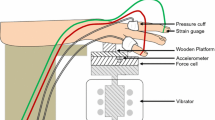Abstract
Objectives
To investigate the dependency of temporary threshold shift of vibratoty sensation (TTSv) in fingertip on hand-arm vibration exposure period.
Methods
Six healthy students were instructed to grip a vibrating or nonvibrating handle in the experimental room. The gripping force was 40 N. The vibratory sensation threshold at 125 Hz was measured before and after the exposure in the exposed middle fingertip. The exposure vibration was vertical and the 1/3 octave-band vibration with had a central frequency of 200 Hz and an intensity of 39.2 m/s2. The exposure periods were 8, 15, 30, 60, 120, 240 and 600 s. TTSv,t was evaluated as the difference in vibratory sensation threshold between immediately before and t seconds after the exposure.
Results
TTSv recovered exponentially as in several previous studies and its use enabled us to estimate the time constant and TTSv,0. TTSv,0 with vibration exposure was significantly larger than that without it. The regression analysis of the relationship between vibration exposure period (T) and TTSv,0 (T) for each subject confirmed the good fit of the equation TTSv,0(T)=B0+B1 *Log10(T), where B0 and B1 are the calculated constants (adjusted R2=0.56–0.87). The time constants did not show such a clear dose effect relationship of exposure period as TTSv,0.
Conclusion
The dependency of TTSv,0 on vibration exposure period was asymptotically proportional to the logarithm of gripping period. To more quantitatively confirm the relationship of the time constants for recovering time course of TTSv, it may be necessary to improve the measurement method for TTSv.
Similar content being viewed by others
References
Nishiyama K, Watanabe S. Temporary threshold shift of vibratory sensation after clasping a vibrating handle. Int Arch Occup Environ Health. 1981;49:21–23.
Nishiyama K, Taoda K, Yamashita H, Watanabe S. Application of a new, self-recording, vibratory sensation meter to measure temporary threshold shift of vibratory sensation caused by local vibration exposure. Int Arch Occup Environ Health. 1994;66:97–102.
Nishiyama K, Taoda K, Yamashita H, Watanabe S. The temporary threshold shift of vibratory sensation induced by the composite vibration exposure. Int Arch Occu Environ Health. 1996;68:255–261.
Nishiyama K, Taoda K, Yamashita H, Watanabe S. The temporary threshold shift of vibratory sensation induced by vibrating handle and its gripping force. Int Arch Occu Environ Health. 1996;69:45–52.
Nishiyama K, Taoda K, Yamashita H, Watanabe S. The temporary threshold shift of vibratory sensation induced by hand-arm vibration composed of four one-third octave band vibrations. J Sound Vib. 1997;200:631–642.
International Organization for Standardization. Mechanical vibration guidelines for the measurement and the assessment of human exposure to hand-transmitted vibration (ISO 5349) 1986.
International Organization for standardization. Mechanical vibration—Vibrotactile perception thresholds for the assessment of nerve dysfunction—Part 1: Methods of measurement at the fingertips (ISO 13091-1) 2001.
Ward WD. Auditory effects of noise. In: Berger EH, Ward WD, Morrill JC, Royster LH editors. Noise and Hearing Conservation Manual. Akron, OH: American Industrial Hygiene Association; 1986.
Griffin MJ. Handbook of Human Vibration. Academic Press; 1990.
Hirosawa I, Nishiyama K, Yamashita H, Watanabe S. Temporary threshold shift of temperature sensation caused by vibration exposure. Int Arch Occup Environ Health. 1992; 63:531–535.
Yamada S, Sakakibara H. Research into hand-arm vibration syndrome and its prevention in Japan. Nagoya J Med Sci. 1994;57 Supplement:3–17.
Malchaire J, Rodrigues Diaz LS, Piette A, Gonclves Amaral F, de Scaetzen D. Neurological and functional effects of short-term exposure to hand-arm vibration. Int Arch Occup Environ Health. 1998;71:270–276.
Malchaire J, Piette A, Rodrigues Diaz LS. Temporary threshold shift of the vibration perception threshold following a short duration exposure to vibration. Ann Occup Hyg. 1998;42:121–127.
SAS Institute Inc. SAS/STAT user’s guide, version 6, 4th ed. Vol 2, SAS Inc, 1990.
SPSS Inc. SPSS-X user’s guide, 3rd ed. SPSS Inc, 1999.
Author information
Authors and Affiliations
Corresponding author
Rights and permissions
About this article
Cite this article
Nishiyama, K., Taoda, K. Dependency of temporary threshold shift of vibratory sensation in fingertip on 1/3 octave-band hand-arm vibration exposure period. Environ. Health Prev. Med. 11, 108–114 (2006). https://doi.org/10.1265/ehpm.11.108
Received:
Accepted:
Issue Date:
DOI: https://doi.org/10.1265/ehpm.11.108




